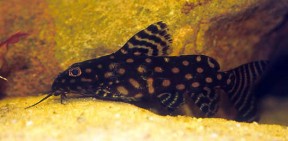Synodontis angelicus
Polka Dot Synodontis
SynonymsTop ↑
Synodontis angelica Schilthuis 1891; Synodontis tholloni Boulenger 1901; Synodontis werneri Boeseman 1957; Synodontis angelicus var. zonatus Poll 1933
Classification
Order: Siluriformes Family: Mochokidae
Distribution
Democratic Republic of Congo, Cameroon, Republic of Congo. It is usually found in slow moving areas of rivers.
Habitat
Democratic Republic of Congo, Cameroon, Republic of Congo. It is usually found in slow moving areas of rivers.
Maximum Standard Length
10″ (25cm) although specimens of up to 23″ have been recorded in nature.
Aquarium SizeTop ↑
48″ x 18″ x 15″ (120cm x 45cm x 37.5cm) – 200 litres)
Maintenance
An aquarium with a soft substrate and rocks, pieces of driftwood and twisted roots arranged to form hiding places suits this species. Floating vegetation is also recommended in order to diffuse the light entering the tank. Other planting is beneficial but not essential.
Water Conditions
Temperature: 75-82°F (24-28°C)
pH: 6.0-8.0
Hardness: 3-20 dH
Diet
Synodontis are omnivorous and are most unfussy in terms of feeding. Frozen, live and dried foods are all accepted. It also relishes vegetable matter in the form of shelled peas, cucumber etc., which it will rasp at with the teeth in its lower jaw.
Behaviour and CompatibilityTop ↑
Should not be kept with any fish so small as to be considered food. Ideal tankmates include Alestiid tetras, robust cichlids (particularly West African species), Mormyrids, Knifefish, Gouramis and larger rasboras and barbs. It tends to become increasingly territorial as it matures and adult specimens are often completely intolerant of other bottom dwellers, especially other Synos. Not recommended for the general community.
Sexual Dimorphism
Mature females are plainer than males and lose much of their colour. It can also be sexed by examining the genital papillae. This is not for the amateur however. The fish should be held ventral side up in the palm of your hand. The dorsal fin should be taken between your middle and ring fingers in order to avoid being pierced by the sharp dorsal fin rays. The genital area you are looking for is concealed beneath the pelvic fins. This can be exposed by pulling (gently) on the caudal fin. A male fish will exhibit an extended papillae which should be pointed and ridged. The spermatoduct can be seen on the caudal side. Females also have a clearly visible papillae but this is more rounded and the oviduct is on the opposite side to the male’s spermatoduct. Most species of medium/large Synodontis can be sexed using this method but it should be noted that most species take 2 years or more to reach sexual maturity.
Reproduction
Not achieved under natural conditions in aquaria, although captive breeding has occured in Eastern Europe via the use of hormone injections. Many of the young fish that come onto the market may have been produced in this way. In nature S. angelicus breeds in areas of seasonal flooding that are rich in micro-organisms. They are egg scatterers and exhibit no parental care.
NotesTop ↑
A very nocturnal species that will be seen only infrequently during daylight hours. S. angelicus is very long-lived and can survive for over 20 years if maintained correctly.
S. angelicus was much sought after when first imported and commanded a correspondingly large price. They are still relatively expensive, though prices have dropped considerably. It is quite a rare species in its native waters.
The patterning and colour varies cosiderably, depending on type locality. Some specimens have white spotting, others yellow, and the base colour may vary from grey through to black. Other fish may even exhibit areas of barring on the body.
Also referred to as the Angel Synodontis.


November 6th, 2019 at 7:34 pm
The scientific name for this fish is incorrect. It is Synodontis angelicUS, not angelicA. Fishbase lists angelica as a common misspelling, and Eschmeyer’s agrees.
November 26th, 2019 at 7:10 pm
Fixed, thanks for the heads up!